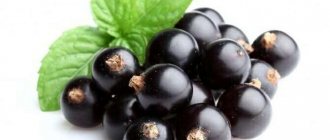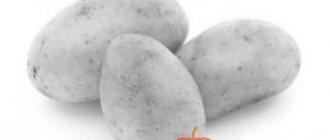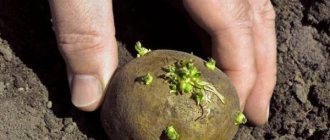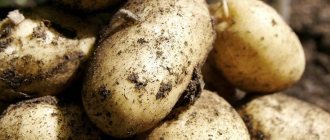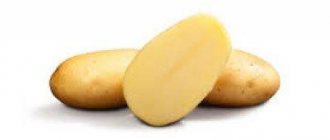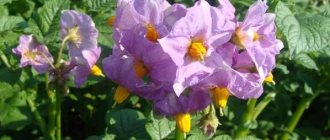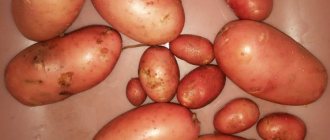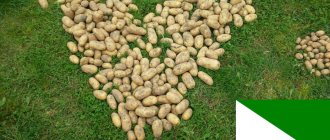The garden of Peter I, from which potatoes began their march across Russia
The homeland of the “second” bread beloved by all Russians - potatoes - is South America, the Andes, where wild species are still found in the mountains.
It was first brought to Europe (Spain) in the second half of the 16th century by conquistadors, who, along with looted gold and silver, brought potato tubers as food. Long before the advent of Europeans, Indian tribes used this plant for food. Until the first half of the 18th century, potatoes were little known. It was considered a delicacy in those days, and only wealthy people could consume it. In those days, potato flowers were more often used to make boutonnieres, which were used to decorate hats, hairstyles and dresses.
According to legend, potatoes were brought to Russia by Peter I and the tubers were planted in a garden in Strelna, near the Wooden Palace. Potatoes at that time were considered a very refined dish, and they were served only at the royal table, and they were sprinkled with powdered sugar, not salt.
Since 1765, during the reign of Empress Catherine II, this vegetable has become most widespread throughout the Russian Empire. Today we can no longer imagine our table without traditional potato dishes. The tubers of this crop contain on average up to 18% easily digestible starch, up to 2.5% high-quality proteins, 1% fiber, 0.3% fat, up to 1% mineral salts, carotene, vitamins C, B1, B2, B6, PP , K. Potatoes are a light-loving crop, they are demanding on soil fertility, so the following conditions are necessary for its cultivation: the soil must have a deep arable layer, rich in humus and neutral acidity. To create these conditions, organic fertilizers are applied in the fall (manure - 4-5 kg/m²; mineral fertilizers: superphosphate - 15-20 g/m²; potassium sulfate - 20-25 g/m² and dolomite flour - 20-25 g/m² ).
Before planting, tubers are usually germinated at a temperature of + 15...16°C for five weeks. Favorable conditions for planting are when the soil has time to warm up to a depth of 8–10 cm and its temperature is at least + 7°C. When planting, you can additionally add another 50–80 g of wood ash or Kemira-potato fertilizer to each hole at the rate of 15–17 g per hole.
Tubers in a row are placed at a distance of 25–30 cm with a row spacing of 60 cm - for early varieties; for mid- and late-ripening varieties, the planting density is 30–35 cm and the row spacing is 70 cm. During the growing season, potatoes need hilling: the first of them is carried out when the sprouts reach a height of 10–12 cm; the second - with a stem height of 15–20 cm. The treatment of row spacing is completed by the time the plants close. Harvesting of early-ripening potato varieties begins in mid-July, mid- and late-ripening varieties - in August and September.
To obtain a stable and high potato yield, it is necessary to have healthy varietal planting material. To select tubers on your site, pay attention to those plants that developed well during the growing season and gave the greatest yield per bush. It is from these potato bushes that the tubers (weighing 50–80 g) are set aside for seed. Since we cannot predict the weather conditions of the current season, to ensure a stable harvest we need to plant at least two to three varieties.
Potatoes can be grown in one place for 3–5 years, but it must be remembered that they should not be planted after nightshade crops (peppers, tomatoes, eggplants). To improve the health of the soil after harvesting, you can sow winter rye as green fertilizer in the beds where potatoes grew. Below are characteristics of some of the most productive varieties that give good results when grown in our gardens. All of them were grown in different years in the beds near the Palace of Peter I in Strelna. Last season, we grew in our garden the varieties Nayada, Charodey, Pamyati Osipova, Sudarushka, the seeds of which were given to us by Belogorka scientists. The tuber harvest in our beds turned out to be very good in the conditions of the past hot summer.
Features of growing potatoes in the North-West region
The homeland of potatoes is the warm, one might say hot, countries of South America - Peru and Bolivia, where the tubers were not only consumed as food, but were also the object of religious cult.
Potatoes are still revered in Peru
A lot of time has passed since then. The painstaking work of breeders has led to the emergence of new varieties of this miracle vegetable. At the moment, potatoes can be grown even in areas of so-called risky farming - for example, in the North-West region.
A feature of the region, located within a temperate continental climate, is the abundance of precipitation, which often leads to waterlogging of the soil. And summer cannot be called too warm - the average temperature in July is only 14.3°C. In order to grow a good potato crop in such conditions, you need to use competent agricultural technology and choose varieties that are not afraid of low temperatures and high humidity.
Site selection
The choice of landing site plays an important role. The main condition for potatoes is a large amount of sunlight, which illuminates and warms the plantings. There is no need to be afraid that direct rays will burn the tops - if you use the right agricultural technology, this will not happen. But the shadow will negatively affect the quality of the crop. It is advisable to protect potato bushes from prevailing winds. And of course, you need to take into account the terrain; potatoes are planted only on flat areas.
Be sure to follow crop rotation. Tomatoes, peppers, and eggplants are not the best predecessors for potatoes. These plants accumulate pathogens that can threaten potatoes. By the way, the pests of representatives of the nightshade family are also the same.
It is impossible to plant potatoes in the same area year after year. The site must rest for at least 3 years before being used for planting again. Ideal predecessors would be legumes, root vegetables, cucumbers, and cabbage.
Potatoes are a heat-loving plant; to plant them you need to find the most illuminated place
How to prepare the soil
In order for a variety to fully reveal its qualities, it is necessary to take into account the structure of the soil and its nutritional value. The root crop prefers to grow in uncrowded conditions; it needs loose soils that conduct moisture well and have unhindered air exchange.
In the North-Western region, including the Leningrad region, all types of podzolic soils, loams and soddy-podzolic soils predominate. These types of soils are not very suitable for growing potatoes. To improve their mechanical properties, it is necessary to carry out preparatory work before planting the root crop. It includes the following steps:
- In the fall, the site must be dug up. The deeper the better. Before digging, rotted manure - up to 6 kg, double superphosphate - 50-70 g, potassium - 30-50 g, ash - 300 g - are evenly scattered on the surface of the earth. The indicated amount is calculated per 1 m2. Do not break large clods of earth. Under the influence of precipitation and wind, they will disintegrate on their own.
- In the spring, digging is carried out only if the earth has become compacted during the winter, and only shallowly, half a shovel deep. But basically it’s enough to just loosen the soil with a fork. If nutrients were not added in the autumn, they can be added a month before planting under digging or directly into the hole.
A few additional tips:
- if the soil contains a lot of clay, during the preparatory period you need to add a large amount of sand for digging, which will increase the looseness of the soil;
- Only rotted manure should be applied, and it is best to do this in the fall. This measure will allow you to avoid a number of diseases and watery tubers;
- with increased acidity, it is necessary to alkalize the soil. But do not overdo it with the norm, a large amount of lime can cause tuber scab;
- An excellent way to increase soil fertility is pre-winter sowing of green manure, such as rye or mustard. It is carried out 1.5 months before frost.
Before planting potatoes, the soil must be dug up and fertilized.
Tuber preparation
An early potato harvest can only be obtained if sprouted tubers are planted. About a month before planting, the selected potatoes are taken out of storage and sorted again. The most suitable tubers for germination are the size of a chicken egg.
- For germination, select a bright room with a constant temperature of 15 ° C.
- Potatoes are placed in low boxes or trays. A large number of tubers can be laid out on the floor.
- Sprouted potatoes should be turned over periodically and lightly sprinkled with water to prevent them from shrinking.
If you are a little late with the start of germination, and planting time is running out, there is one wonderful method - a peat-humus mixture with sand. It is poured into containers and potatoes are placed on top. Temperature and light indicators should be the same as during germination using the usual method. Periodically wetting the tubers with water will help them quickly grow sprouts with a root system. The only inconvenience of this method is that you will have to plant it manually and very carefully so as not to damage the fragile roots.
Potatoes are germinated before planting
Landing dates
Many gardeners in the North-Western region consider the beginning of bird cherry flowering and the opening of young leaves on the birch tree to be a guideline for planting potatoes. The main thing is that at a depth of 8 cm the earth has time to warm up to 10°C.
When planting, you should take into account the features of the spring period:
- if spring is cold and damp, potatoes need to be planted shallowly - 8-10 cm, so that the tubers warm up properly;
- in warm and dry weather, you can bury the tubers deeper, 10–15 cm.
Planting methods
In the North-West region, gardeners choose the same planting methods as in other regions. Some people prefer to use the classic “shovel” method. This method is mainly used in small flat areas located in the southern part of the garden. Its advantages are simplicity and time saving.
Planting potatoes in holes is used in small areas
The ridge method is more suitable for heavy soils in which potatoes grow deformed and small due to lack of space for tuber development. The same method is used in swampy and frequently flooded areas, where potatoes can simply rot in the water.
The ridge method is used in clayey or flooded areas
Many gardeners in the region try to plant potatoes in furrows or trenches, directing them from south to north so that the potato bushes can receive more light and heat. Ridge and trench methods are suitable for owners of walk-behind tractors and large plots of land.
The trenches should be positioned from south to north so that the potato bushes are well lit
Using the listed planting methods, you can get good yields of early and mid-early potatoes. The rapid growing season allows the tubers to ripen in a short time. But in the climatic conditions of the North-Western region, when grown in open ground, mid-late and late varieties are not always able to produce a harvest on time. What to do? The answer lies under the film in the literal sense of the word. To ensure that late varieties of potatoes can please you with the taste and size of the tuber, use greenhouses and film shelters (greenhouses).
Potatoes are planted in a greenhouse much earlier than in open ground. This is possible because the soil in a closed space warms up much earlier. In addition, in greenhouse conditions it is quite easy to maintain the temperature necessary for the growth and development of potatoes. The planting technology is the same as in open ground, but there are more advantages:
- Potatoes can be grown 8 months a year;
- harmful insects are practically absent;
- care requires minimal costs;
- The yield in a greenhouse is much higher than in open ground.
There are many benefits to growing potatoes in a greenhouse.
A film shelter or greenhouse will also allow you to plant potatoes a little earlier. Plastic film will protect the tubers from frost, and you will get the harvest 2 weeks earlier. Building such a shelter is very simple. Metal arcs are installed on the potato bed, a transparent film is stretched on top and secured at the base. But growing under cover has one caveat. While the potato sprouts are sitting in the ground, they do not require ventilation. But the emerging shoots need air. The film delays it, so you will have to lift it periodically. And when the tops grow 15 cm, holes are made on the surface of the film in a checkerboard pattern to ensure ventilation of the shelter.
In a greenhouse, potatoes are not afraid of frost
Another important point when growing potatoes under film is maintaining the temperature inside the greenhouse. If the weather is sunny, the ground under the structure can warm up to 40°C or higher. Such a high temperature will stop the development of tubers. Therefore, in sunny weather the film can be removed, but if frost returns, the structure should be returned to its original appearance.
The best varieties for the North-West:
Charodey (zoned since 2000). Mid-early variety, white tubers, weighing 80–120 grams. The tubers contain 18–22% starch and have an excellent taste. When cooked they are semi-crumbly. The pulp is white. Marketability 92–95%. This variety is not afraid of sprouts breaking off, and tuber “babying” is not observed. Their keeping quality is good. The variety is resistant to cancer and viroid, moderately resistant to macrosporiosis, common scab, and viral diseases. It is highly resistant to late blight. Its root system is so powerful that even in drought conditions it allows plants of this variety to remain green, maintaining good turgor. The Magician variety blooms very profusely, and its large white flowers have a pleasant scent.
Article on the topic: Potato variety “Saprykinsky” - description and photo
League. The variety is early, universal, high-yielding. Starch – 16–19%. The taste is excellent. The variety is resistant to cancer, golden potato nematode; relatively resistant to late blight, scab, and viral diseases. The tubers are white, oval (very beautiful), the eyes are very small. The pulp is slightly creamy. The keeping quality of the tubers is good. They are suitable for making chips. Since 2005, the variety has been undergoing State Variety Testing.
Skazka (zoned since 2004). This variety also has medium-early tuber ripening. Its average yield is approximately 400 c/ha. The marketability of tubers is 85–88%. The taste of the tubers of this variety is very good. The starch content in tubers is 14–17%. The variety is resistant to cancer, moderately resistant to macrosporiosis, common scab and viral diseases. It has a very high degree of resistance to late blight. A distinctive feature of the Skazka variety is its multi-tuberism - it can produce up to 30 or more tubers from each potato bush. Although the size of these tubers and, accordingly, the yield highly depend on the growing conditions. This variety prefers light loamy and sandy loam soils, developed peat bogs. Doesn't like excessive moisture. Under favorable conditions, it can produce a high yield when grown even from small tubers. Skazka's tubers are round-oval, white with pink spots of various shapes around the eyes. The eyes are small and red. The pulp is white.
The bush is erect, of medium height. The flowers are pale lilac with white tips.
Scarlet Sail is a mid-early, universal variety. It is high-yielding - 400-500 c/ha, highly starchy - 18.5-23.3%. The taste is excellent; when boiled, these potatoes are semi-crumbly. Its flesh is creamy. The variety is resistant to cancer, golden potato nematode, late blight, and relatively resistant to common scab and viral diseases. Its tubers are intense pink, very beautiful, oval, the eyes are small. The keeping quality of the tubers is good. They are suitable for making puree. Since 2007, the variety has been preparing for transfer to the State Variety Test.
Danaya is a mid-early variety of universal use, high-yielding - produces 400–500 c/ha. The starch content in tubers is 15–18%. The taste of the tubers is excellent. The pulp is slightly creamy. The variety is resistant to cancer, golden potato nematode, relatively resistant to late blight, common scab, and viral diseases. Its tubers are short-oval, slightly flattened, white. The eyes are very small. The keeping quality of the tubers is good. The variety is suitable for making chips.
Naiad (zoned since 2004). Mid-season variety for universal use. It has excellent taste; when cooked, the tubers are crumbly and have white flesh. The starch content in tubers in some years reaches 25%. Productivity 350–470 c/ha. The variety is resistant to cancer, golden potato nematode, relatively resistant to late blight, common scab, and viral diseases. The keeping quality of the tubers is good. It has white oval tubers and small eyes. The variety is suitable for making chips and purees.
Inspiration (zoned since 2006). Mid-early variety. Dining room. It has a high yield - 500–600 c/ha. The starch content in tubers is 14–19%. The taste of its tubers is very good. Their flesh is white, dense, and does not darken when cut. The variety is resistant to cancer, golden potato nematode, above average resistance to late blight, relatively resistant to common scab; weakly resistant to rhizoctonia and viral diseases. Its tubers are white and long. The eyes are very small. The keeping quality of the tubers is good.
The Mystery of Peter (zoned since 2005). Mid-season variety for table use. High-yielding - up to 450–550 c/ha. Has good taste. The starch content in tubers is up to 14–19%. The variety is resistant to cancer, highly resistant to late blight, rhizoctonia, and relatively resistant to common scab, viral diseases, and macrosporiosis. The keeping quality of the tubers is good. The tubers are oval, very beautiful, pink, with small, red eyes.
Charm is a mid-season variety of universal use. It is high-yielding - 400–500 c/ha. The starch content in tubers is 17–21%. The taste of the tubers is excellent; when boiled, they are semi-crumbly. The pulp is slightly yellow and does not darken when cut. The variety is resistant to cancer, golden potato nematode; relatively resistant to late blight, viral diseases, and common scab. The tubers are yellow, very beautiful, round-oval, the eyes are very small. The flesh is creamy and does not darken when cut. The keeping quality of the tubers is good. These potatoes are suitable for making mashed potatoes and also for making chips. State variety testing has been taking place since 2006.
I wish all gardeners good harvests in the new season!
Elena Kuzmenko, master landscaper of the Peterhof State Museum (Peter I Palace in Strelna)
The best potato varieties for the North-West region
Potatoes love sunlight and warmth, and in the North-West region, where autumn comes in mid-August, winter in November, and the summer heat lasts for at most 2 weeks, not all types of potatoes will be able to fully grow and ripen. Today, potato varieties have been developed for the North-West region that are resistant to climate change and have an early ripening period.
The best potato varieties for the North-West region
Yield potato varieties for the North-West - description, characteristics, photos
When choosing productive potato varieties for the Northwestern District, it is worth considering not only the description, photo and characteristics of the varieties, but also the proper care that the plants need throughout the entire growing season. When grown correctly, productive potato varieties for the North-West can be distinguished as follows:
Aurora is a well-known representative of the potato crop, patented by the Vsevolozhsk Breeding Station, and can be cultivated not only in the Northwestern District, but also in the Central, Volga-Vyatka, and Far Eastern regions. In terms of ripening – mid-season. The potato is oval in shape, the skin is reddish in places, and the flesh is white inside. Harvest 20-25 tubers from one bush . Excellent taste, potato boiliness is average. It is worth noting that the Aurora potato is resistant to diseases such as potato canker and nematode, and also has good resistance to late blight of tubers and leaves;
Bafana - included in the State Register, approved for use in Russia, since 2013, has a patent from KWS Potato BV The potato is elongated-oval, the skin is yellow in color, and the flesh is ordinary white. Ripening time is medium late. Belongs to the category of table potatoes. Excellent taste as advertised, not too soggy. The yield is excellent. Highly resistant to nematodes and potato blight;
Vektar Belorussky is a patented potato variety, which is also approved for use in the Russian Federation, in the State Register since 2013. The potato is round-oval, with a red skin and yellowish inside. Excellent taste, high yield, excellent storage. Suitable for cultivation on all types of soil, resistant to damage;
Gala is productive, but, unfortunately, it can suffer from late blight of tubers and leaves . Ripening period is mid-early. It has proven itself excellent in cooking, the flesh is yellow in color. Patented, can also be grown in the central and Volgo-Vyatka regions;
Delphine – productive, very good in taste. The skin is red, the flesh is light yellow. Average ripening period. When cooked, it practically doesn’t get overcooked. It stores well and has a marketable appearance; it is often grown for sale. Suitable for cultivation only in the North-West. Resists potato cancer and nematode, but can be slightly affected by late blight;
Peter's Riddle is a well-known productive variety for the North-West, but can also be grown in the Northern, Volga-Vyatka, Far Eastern, and Middle Volga regions. Red on the outside and creamy on the inside. Included in the State Register since 2005. Ripening period is average. The number of tubers per bush is up to 25 . True, not everyone likes the taste, however, good taste is declared. Excellent storage in winter.
Click on the variety name to see photos
variety Avrorasort Bafanasorta Vectarsort Galasorta Peter's Mystery
Potato varieties Aurora
Bafana potato varieties
Potato varieties Vektar Belorusski
Potato varieties Gala
Potato varieties Peter's Mystery
In addition to the above, the productive varieties for the North-Western District include the following: Zorachka (early), Caprice potatoes show excellent yield (patented), Cascade, Liga, Lileya Belorusskaya, Lomonosovsky, Lorch, Lugovskoy, Lucinda, Manifesto, Music, Naiad, Nevsky, Nikulinsky, Orchestra, Pushkinets, Ramensky, Ramos, Real, Red Scarlett, Rosara, Sagitta, Santana, Sante, Safiya, Silvana, Lilac Fog and others.
Variety selection
The choice of variety is influenced by its characteristics:
- Ripening time. According to the description, 50-60 days pass from the moment the first shoots sprout to the full maturation of the early species. Mid-early varieties of potatoes are also suitable for the Leningrad, Moscow and Kaliningrad regions, the ripening period of which is from 70 to 90 days.
- Susceptibility to disease. In the North-West region, it is permissible to grow varieties that are resistant or moderately susceptible to diseases and can withstand cold weather and constantly high humidity.
- Productivity.
- Easy to store, not susceptible to spoilage.
Article on the topic: Potato variety “Sarma” - description and photo
Popular varieties
Zhukovsky early
According to the description, this variety stands out among domestic species. This is a productive variety: up to 450 kg are harvested per hundred square meters. The fruit pulp is white, the tubers are oval, with pink skin. Potatoes of this type are resistant to weather changes in the North-Western region and to the golden nematode, which, with high humidity, fills the entire area.
The species has no immunity to scab and late blight.
The sorcerer is a mid-early species with a yield of up to 400 kg per hundred square meters and is distinguished by a pleasant sweetish taste. The pulp of the variety is light cream in color, does not darken in boiling water, and the peel is yellow.
The variety is characterized by uneven growth of tubers: they differ significantly in size. The advantages of this type are ease of care, drought resistance, high shelf life, and portability of transportation. Potatoes do not suffer from sprouts breaking off.
Resource and Bronnitsky
Gardeners should not neglect old mid-season varieties such as Resurs and Bronnitsky. These varieties of potatoes grow well in the Leningrad and Vologda regions.
The yield of the Resurs variety is as follows: it brings 450 kg per hundred square meters even in the northernmost regions. It is weakly affected by viral diseases.
Bronnitsky variety has good seed characteristics. In Russia, this is one of the best varieties for growing in cold and humid climates. The peel of the fruit is thin, light golden in color.
Bronnitsky can easily compete with famous German and Dutch varieties: its yield is 540 kg per hundred square meters. In this case, root vegetables weigh 90-120 g.
Charoite is a new variety; in the North-West region it is called St. Petersburg Skorospelka. The first fruits can be collected 60 days after planting. yield - 320 kg per hundred square meters. Charoite has a good taste and light yellow skin. For an early ripening species, it is preserved almost perfectly: the keeping quality rating is 96%. It is highly resistant to cancer and moderately resistant to late blight and scab.
The disadvantages of the Charoite variety include its tendency to be damaged by the golden nematode, so some gardeners continue to look for new types of potatoes similar to Charoite, but more resistant to diseases and pests.
Manifesto and Damaris
The mid-early Manifest potato variety is considered more productive than other similar varieties. With an optimal combination of fertilizers and proper care, 460 kg per 100 sq. m. Root vegetables are red.
The mid-early species Damaris also has excellent yield - 450 kg per hundred square meters. Potatoes have a beige skin, an oval shape, their flesh is light yellow, and the taste is delicate. Damaris stores well for a long time.
Manifest and Damaris are considered popular varieties in Russia, moderately susceptible to late blight and almost unresponsive to the pathogens of cancer, scab, both types of mosaics, leaf curl virus and golden nematode.
Care
The agricultural technology of potatoes grown in the North-West region differs little from the generally accepted ones, with the exception of hilling and watering. If the weather during the growing season is damp, then there is no need to water the potatoes. At the beginning of development, the plant has enough water and nutrition, which are in the mother tuber. But when the moment of budding comes, fluid consumption increases. And if during this period the weather is hot without rain, then the potatoes need to be provided with abundant watering.
Hilling up in difficult climatic conditions is carried out more often - up to 3 times. The first time, the sprouts are covered to the very top to avoid exposure to frost. With each regrowth of seedlings, the procedure is repeated until the threat of recurrent cold snaps has passed.
The row spacing will have to be loosened at least 2 times. This procedure retains moisture in the soil and increases air exchange in the roots. For the North-Western region and the Leningrad region, where it often rains in summer, loosening is even better than moistening. In addition, loosening is an excellent way to combat weeds, and this is especially important at the very beginning of tuber germination. In addition, many pests, including wireworms, do not like this procedure.
Hilling and loosening potatoes in the North-West region is a very useful procedure
Of course, potatoes cannot do without nutrients, especially late varieties. Taking into account the mineral fertilizers applied during planting, potatoes need at least two feedings: the first time before the first hilling, the second time during the flowering period. It is more advisable to combine fertilizing with watering or carry it out after rain. Preference should be given to organic fertilizers - a solution of chicken manure (1 part to 15 parts water) or ash (2-3 tbsp per bush).
Unfortunately, diseases and pests do not bypass potato planting. For the North-West region, the main problems are late blight and scab. To prevent these diseases or at the first signs, be sure to treat the bushes with Abiga-Pik or BisolbiFit.
The most common pests are the golden potato nematode, the Colorado potato beetle, the potato aphid and the wireworm. To prevent the invasion of unwanted guests, it is necessary to correctly perform agrotechnical techniques. You can plant fragrant herbs - their smell will repel pests. And of course, crop rotation must be observed.
Photo gallery: potato diseases and pests common in the North-West region
Phytophthora is one of the most dangerous diseases that affects both tubers and tops. In tubers affected by scab, the level of starch decreases, which spoils the taste of potatoes. The golden nematode destroys the crop. The Colorado potato beetle and its larva harm the tops. Potato aphids feed on the juices of the plant, severely depleting it. Wireworm makes tubers unsuitable for storage
Dutch potato varieties
Dutch varieties are popular in our country
In the Netherlands, summer is short and unpredictable, the weather can be called hot for 2-3 weeks a year, and air and soil humidity is almost 100%: all this is reminiscent of the conditions of the North-West region in Russia, which is why growing Dutch varieties of potatoes is so popular in our country.
Advantages of foreign varieties
- Productivity.
- Insensitive to temperature changes, good tolerance to drought and high humidity.
- Resistance to harmful viruses and bacteria.
- Good preservation and transportability of tubers.
- Aesthetics.
Red Scarlet and Impala
Red Scarlet is suitable for lovers of young potatoes. Up to 500 kg of crop is harvested from one hundred square meters. The tubers are reddish, very smooth. Gardeners value the variety for its immunity.
The maximum yield of the early Impala species is 370 kg per hundred square meters. Impala is immune to cancer and golden nematode, calmly reacts to short-term drought, and is undemanding to the type of soil. Impala is susceptible to late blight.
Fresco requires 60-70 days to fully ripen. Productivity - 230 kg per hundred square meters. Gardeners recommend collecting Fresco tubers as early as possible, before potato late blight appears on them.
This variety is insensitive to cancer and nematode, 50/50 to viruses, black and common scab. Medium-sized yellow and round potatoes are suitable for making chips and crispy French fries.
The Fresco variety is poorly stored: the slightest increase in temperature in the cellar provokes germination.
New potato varieties
Some varieties have dropped out of the race, unable to withstand the competition, and some have not left their pedestal for many years. But science does not stand still. New potato varieties with improved qualities are appearing.
- Ivory Russet. This variety was included in the State Register in 2015. Belongs to early ripening. On the 45th day you can collect from 62 to 121 c/ha. On the 55th day, the yield is already 153–208 c/ha. The maximum figure is 420 c/ha. The elongated root crop is covered in a peel with a yellowish color. The eyes are small and insignificant. The pulp is white, contains up to 18.2% starch, and tastes good. Tuber weight 82–181 g.
- Charoite. Included in the State Register in 2014. The shell is yellow, the flesh is slightly lighter. Contains almost 17% starch. The average weight of the elongated oval root crop is 100–143 g. The marketability of the tubers is 82–98%. Maximum yield 382 c/ha. Not afraid of cancer, can fight late blight and banded mosaic with average effort. It is susceptible to attacks by the golden nematode.
- Christel. The newest variety. The year of inclusion in the State Register is 2022. The oval-round root crop weighs 94–138 g. The eyes are located at shallow and medium depths. The skin and flesh are the same color - yellow, but the flesh is slightly darker. Taste good to excellent. Contains up to 14.7% starch. Maximum yield 617 c/ha. Resists banded mosaic and cancer, nematode-resistant. May suffer from late blight of tops and tubers.
Be sure to take this opportunity to try growing new selections. Perhaps you will find exactly the variety that will become a favorite on your site.
Don’t be afraid to experiment and plant different varieties of potatoes on your plot. It is quite possible to grow even late potatoes in the conditions of the North-Western region. Of course, you have to work hard, but the result is worth it. It’s so nice to grow your own young potatoes, and in winter a supply of this vegetable will also come in handy.
- Author: Irina Morenko
Good day! My name is Irina. I live in a wonderful place - Crimea. By education - a teacher. I really love nature and animals. I have been interested in floriculture for a long time, but I have only just begun to master the wisdom of gardening. My motto is – live forever, learn forever. Rate this article:
- 5
- 4
- 3
- 2
- 1
(0 votes, average: 0 out of 5)
Share with your friends!
Related posts:
The best potato variety for Siberia
Potato variety Zhukovsky: early harvest in your garden
The best varieties of petunias - long-known and beloved, as well as new varieties and hybrids
Similar articles:
- The best potato varieties for the Moscow region The Moscow region is a zone of risky farming. It’s not easy to grow potatoes here, because you need a variety that doesn’t…
- The best varieties of potatoes for growing in mid-latitudes Potatoes are very popular in our country and are grown in almost every area. With the existing...
- We choose the best varieties of eggplants from purple to white and green. The hybrids and varieties of eggplants that exist today are so diverse in shape, size and color...
German potato varieties
German varieties are also excellent for growing in the North-West region, especially in the Leningrad, Arkhangelsk, Kaliningrad and Murmansk regions of Russia.
Adretta brings 450 kg per 100 sq. m, has large yellow tubers that taste great. The tops grow quickly, tubers form early, and the variety tolerates drought easily.
Adretta stores well provided that the tubers are harvested on time and the temperature in the cellar is not too high. In good weather in Russia, the variety is resistant to late blight, cancer and viruses, but is vulnerable to common scab, rhizoctonia and blackleg.
According to the description, the yield of the Karatop variety averages 440 kg per 100 acres of land. Cultivation is carried out in the Leningrad, Moscow, Vologda and Kaliningrad regions. Tubers can be tasted 50 days after the first shoots emerge.
Potato varieties for the Leningrad region
The Leningrad region in terms of climatic indicators is not much different from the North-Western region. Short and humid summers give way to rainy autumns. In such conditions, bushes and root crops often suffer from late blight and rot. Of course, gardeners first of all try to plant early varieties of potatoes - there is less risk and a very quick return on production.
Early potato varieties for the Leningrad region
Both domestic and foreign varieties are grown in the region. Among domestic ones, Zhukovsky early is the leader; its characteristics have already been described. The following varieties have also proven themselves to be excellent:
- Bullfinch. It is valued for its excellent yield - on the 45th day it is possible to harvest up to 130 c/ha, on the 55th it is already 210 c/ha. The maximum yield is 354 c/ha. Can be perfectly stored - shelf life is 95%. An early ripening variety for table use. Potatoes weighing from 59 to 90 g have an oval-round shape. The peel is not entirely smooth, reddish in color. The pulp is white. Starch content is almost 16%. Taste rating from good to excellent. Along with most domestic varieties, Snegir perfectly resists nematodes and the causative agent of potato cancer.
- Spring. This variety was obtained by crossing different types of potatoes, so you can use your own material for germination and planting for a long time. Spring is not afraid of viral infections and has a wonderful taste. This variety has other varieties:
- Spring is white. The variety is famous for its milky white pulp.
- Spring is yellow. Due to the high carotene content, the flesh is yellow in color.
- Spring is early. The variety is distinguished by very early ripening. It is grown through seedlings and harvested at the end of June.
- Adretta. A wonderful variety from German breeders. It tastes great and is rarely attacked by viruses. The only problem is that due to the tubers’ susceptibility to rot, they are very poorly stored.
Photo gallery: early potato varieties for the Leningrad region
Bullfinch has good yield and shelf life
The Spring variety has excellent varieties
Adretta is a wonderful variety of German selection, but its weak point is storage
Early potato varieties for planting in different regions of Russia.
The variety of potatoes can confuse a novice gardener. Which one should you choose for yourself? And so as to get a rich harvest. Therefore dom-v-sadu.ru
I made a selection of what are the best varieties of potatoes and what are the earliest varieties of potatoes that you should definitely plant in your garden. You can choose not only by ripening time, but also by the type of potato that is most suitable for your area.
Article on the topic: Potato variety “Queen Anne” - description and photo
Early and ultra-early potato varieties
Before planting potatoes, you should decide how quickly you need to get the harvest. If tubers are needed very early, then you will have to pay attention to early potato varieties. Moreover, they, in turn, are divided into subgroups.
First: ultra early.
The first tubers can be dug up 40-60 days after planting. This group includes table varieties such as Timo, Ariel and Riviera. The last two allow you to get a double harvest in the southern regions of the country.
Second: mid-early.
They produce a harvest after the 60th day from planting. The entire growing season lasts up to 90 days. Almost the entire group is potato varieties zoned for central Russia. These include: Izora, Anosta, Krepysh and Kholmogorsky.
Third: mid-early.
Allows you to collect ready-made tubers 70 days after planting. Such early potato varieties are suitable for the Moscow region, since the time from mid-May to the end of summer is just enough for a full growing season. The list includes: Amorosa, Marfona, Visa, Odysseus, Romano and White Night.
Dutch potato varieties
If you want to try new potato varieties, you can choose those that were bred in other countries. For example, in Holland. The main advantage of all Dutch varieties is their high yield.
In our country, the most popular are those that have medium-early ripening periods. Many people characterize them as the best potato varieties for the middle zone. Since their growing season fits well into the warm season.
Breeders ensured that the bred potatoes were not susceptible to viruses and cancer. Some of them are even resistant to common scab. As for late blight, it can affect green tops. At the same time, the tubers are unaffected by it.
Popular varieties of Dutch potatoes are:
- Ukama (ultra-early with light yellow flesh) allows you to harvest 60 days after planting;
- Impala (early yellow-fleshed potato) has a growing season of 70 days;
- Condor (mid-early potato with light yellow flesh) is characterized by a ripening period of 90 days; its peculiarity is a small number of tubers under one bush, but they are all large, weighing 120-140 grams;
- Latona and Red Scarlett (two more yellow-fleshed varieties) will produce within 75 days of planting, with the latter being incredibly disease and drought resistant.
Recommendations for different regions of Russia
Potato varieties for the northwestern region:
- Amorosa (early, bred in Holland);
- Impala and Latona;
- Folva (bred in Denmark) is characterized as a variety suitable for making French fries;
- Karatop (table variety, Germany);
- Prigozhiy 2 (Belarus) characterized by high resistance to viruses and cancer, however, susceptible to late blight;
- Rozhdestvensky (Russia) is susceptible to late blight and scab.
The Northwestern region is quite extensive. Therefore, potato varieties for the Leningrad region repeat the list given above. The adjacent regions, located to the south and east, are also areas with similar climatic conditions. Therefore, the recommendations will be the same.
The best potato varieties for the Moscow region will not differ much from those indicated slightly above. This list can be supplemented with several early ones, developed or adapted for the central region:
Potato varieties for Siberia should be ultra-early or mid-early. After all, the warm season in this area is very short. The list of varieties can include the following:
- the previously mentioned Timo, Red Scarlet, Latona;
- an early variety of Ukrainian selection - Lugovskoy;
- Luck with white flesh;
- Ermak, which has a pink peel and white flesh;
- the Kamensky variety is poorly eaten by such pests as the Colorado potato beetle;
- Rozhdestvensky and Garnet.
If you need to choose the best potato varieties for the Urals, then the previous list will be quite suitable. It can be supplemented by two, specially zoned for this area:
- Baron, which has a yellow skin and light yellow flesh;
- Antonina.
Features of cultivation
The Tver region belongs to the North-Western region. In this area, the sunniest month is March, winter begins in November and ends in February. The hot period is short, its average duration is 2 weeks.
It is difficult to grow potatoes in such conditions, so you need to pay attention to the characteristics of the variety. Almost all summer is rainy and cloudy. The first signs of a season change appear already in August.
Tubers differ not only in color, but also in taste characteristics
Time for sowing
When planting vegetables, you need to take into account not only the air temperature, but also how warm the soil is. Without meeting this criterion, you can freeze the tubers, and they will not give a good harvest.
The best time for planting is the first week of May. At this time, the leaves on the birch trees are already visible.
For your information! You need to focus on the soil temperature. To do this, dig a hole at least 9 cm deep, after which you need to touch the ground. If it is warm, then you can plant vegetables.
Selecting a location
The best potato varieties for North-West Russia will grow only on suitable soil. The field should be sunny and protected from drafts. It is advisable to grow cucumbers or cabbage on the plot before this. In the fall you can plant mustard or other grains.
All these crops have a beneficial effect on the soil. They make it loose and light. Access to oxygen to the root system is important for potato development. Before sowing, fertilizers are applied in the form of mullein or diluted bird droppings.
In order for the earth to warm up faster in the spring, it is dug up and beds are formed. Additionally, they can be covered with film; such a small greenhouse will have a beneficial effect on warming up the soil.
Additional measures
Greenhouses and greenhouses allow you to create optimal conditions for growing. In such an environment, varieties ripen earlier, and they are protected from pests and diseases.
Planting in the greenhouse is carried out earlier than in the field
In the Tver region this is done around April. The process itself is standard: the soil is dug up, fertilized, holes are made and germinated seed is placed in them.
A greenhouse is a mini-greenhouse. For this, vegetables are planted in open soil and covered tightly with film. It allows the soil to warm up faster and increase humidity levels.
Note! This method allows you to harvest an early harvest, since the potatoes ripen 2 weeks earlier than in regular soil.
